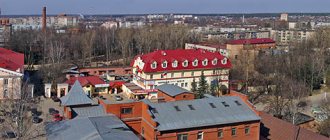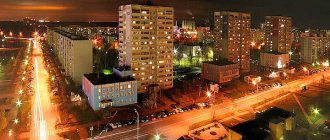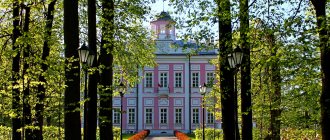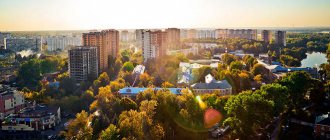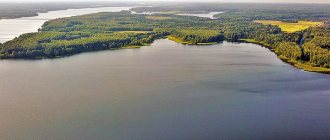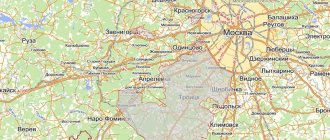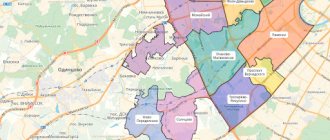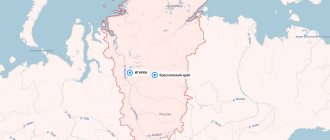The city of Khimki is located just outside the Moscow Ring Road, on the banks of the canal. Moscow, along the Moscow-St. Petersburg highway (Leningradskoye Shosse), adjacent to the capital from the north-west.
The city with a population of 250,000 people received the status of a separate urban district, and is conditionally divided into Old and New Khimki, and they, in turn, consist of the microdistricts: Skhodnya, Podrezkovo, Klyazma-Starbeevo, Novogorsk, Levoberezhny, Planernaya and Firsanovka.
General information and history of Khimki
Once, back in stagnant times, the residents of Khimki came across a difficult riddle in a crossword puzzle in a local newspaper. It was necessary to name the city on the outskirts of Khimki in six letters. All nearby options deliberately did not agree, and thousands of crossword lovers were impatiently awaiting the next issue with answers. The result paid off! The joker-compiler had Moscow in mind. The multimillion-dollar “town” on the outskirts of Khimki has a huge influence on the life of Khimki residents, but, meanwhile, there is a lot of local things here that one can be proud of.
Khimki, pond in the Barashki microdistrict
The city of Khimki is located on the northwestern exit from Moscow on both sides of the Leningradskoye Highway. Accordingly, its southeastern border is the Moscow Ring Road. In addition, the Khimki urban district borders the Moscow districts of Kurkino and Molzhaninovo, the Zelenograd administrative district of Moscow, as well as the Solnechnogorsk, Mytishchi, Krasnogorsk municipal districts of the Moscow region and the Dolgoprudnensky urban district. They laid it down specifically.
The exact coordinates of the city center are 55°54′00″ north latitude 37°27′00″ east longitude.
The offset from UTC is +3:00, which corresponds to Moscow Time Zone (MSK). In addition to the territorial division of Khimki by natural barriers - Moscow, a canal, a railway and a federal highway - there is also a temporary division of the city into 2 parts. The fact is that the meridian 37°30′ E passes through Khimki, which separates the 2nd and 3rd geographical time zones, therefore, if we take it strictly according to science, the time in the west of the city differs from the “eastern” by one hour.
The city of Khimki got its name from the Khimka River. The river originates in the Khimki forest and flows into the Moscow River. In the 1930s, a canal named after Moscow passed along part of the Khimki riverbed. But the river has survived in fragments to this day both in the urban district of Khimki and in Moscow, where it takes a new beginning in springs in the Pokrovsky-Streshnev area, although for the most part it is later laid in pipes.
There are several options for the origin of the name. It was established only by the 19th century, and before that, along its 15 kilometers of length, the river managed to acquire many variants of the name: Khilka, Khinska, Khinka and even Vykhodnaya (in the lower reaches). Possible roots of the river's name are as follows:
- Khilka is the “upper path”, since it is possible that a waterway passed along the river through Vkhodnya (Skhodnya) to the portage at Lama.
- Khimka - from a variant of the male name Fimka, Efim.
- Hin - nonsense, nonsense. That is, a small and insignificant river.
- Himinas – from the Baltic word for moss.
- To cry - according to Dahl's dictionary - to cry, to grieve.
There is also a legend about the drowning of the noble daughter of Khimki, but the reason for her death is kept silent.
But it is known for certain that Khimki was also the name of a village located just south of the current city on the left bank of the river. The village was first moved during the construction of the canal, and over time, the urban-type settlement of Khimki near the Northern River Station merged with Moscow, and mention of it remained only in the name of the Khimki-Khovrino microdistrict. Nowadays, on part of that large village there is a cognac house.
Let's return to our Khimki. Not far from the entrance to the city, away from the Leningradskoye Highway, there is a small wooden arch with an inscription that the Tsar’s Road once ran on the site of a residential microdistrict. Near it, on the banks of Khimki, stood the village of Kozmodemyanskoye with a church named after Kozma and Demyan. The village is gone now, but the church remains, but it is located inside the Moscow Ring Road and is subordinate to the Moscow diocese, although the majority of its parishioners are Khimki residents.
The village was famous for the fact that in 1608-1609 the Poles under the leadership of the Tushino thief False Dmitry II fought here. The Patrikeev estate was also located here. Previously, there were white pillars at its entrance, but time took them away, and the name stuck. Already at the White Pillars hospital, V.I. Lenin was treated, who greatly contributed to the prosperity of the institution. Today, Khimki City Hospital No. 1 is located there, remaining under the control of the city, since for some reason there are no residential Moscow buildings in this area nearby.
Khimki. City hospital
The history of the settlement of Khimki itself began on November 1 (13), 1851, when the first station from Moscow, Khimskaya, was opened on the new St. Petersburg-Moscow railway at the 18th verst. During the ten-minute stops, a staff of 4 people served. But little by little the unit acquired infrastructure: a passenger house, a cafeteria, and a staff of railway workers.
The first travel road ran from the station to the church in Kozmodemyanskoye (now Kirova Street), after which Tsarskaya Alley (now Moskovskaya Street) led to the Petersburg Highway. These places were occupied by summer residents long before the construction of the station.
At the beginning of the 20th century, together with them and the 47 courtyards of the station village, there were about 5 thousand inhabitants in the summer. A telegraph and post office were built in the village, a private pharmacy of a certain Klyachko was opened, who also placed two colonial shops, a tavern, a restaurant with a bowling alley - in a word, he did everything for the people!
Khimskaya station. Photography from the 1960s
Proximity to Moscow determined the growth of Khimki. In 1928, electricity was brought to the city and the first enterprises appeared - a furniture factory, the Spartak metal products artel, a knitwear artel, and a brick factory. In 1932, aircraft repair plant No. 84 was founded. After the completion of the Moscow-Volga canal in 1937, the river port of Khimki was opened, and a small sea was formed - the Khimki reservoir of 3.5 square meters. km, but both the port and the sea were related to the southern “namesake”. The canal almost cut off the left bank part from Khimki along with the Library Institute, but at the insistence of N.K. Krupskaya, the “Levoberezhnaya” platform was built and the district of the same name again merged into the city.
At the end of the 30s, the Leningradskoye Highway was paved, the number of commuter trains was increased, and the construction of aircraft plant No. 301 (now NPO named after S.A. Lavochkin) began. In 1937, Khimki turned from a holiday village into a working one. Production grew at an accelerated pace, construction of multi-storey buildings began, and it was clear that things would not stop there. Therefore, on March 26, 1939, a new city appeared on the map of the USSR - Khimki. Already before the war, two research institutes began operating there: the forestry and wood-chemical industries. In 1940, the Khimki district was formed.
It was in Khimki in the fall of 1941, 23 kilometers from the heart of Moscow, that the hordes of invaders were stopped. Most of the population was evacuated along with their enterprises (aircraft plant No. 84 was transported to Tashkent), but the remaining Khimki residents made a significant contribution to the victory - they dug anti-tank ditches, made hedgehogs, and built bunkers. Workers' artels produced grenades, educational institutions turned into hospitals, old and young joined the militia. The new house near the highway became the headquarters of the 20th Army. In memory of that heroic time, today three huge ten-meter anti-tank “hedgehogs” make up a memorial ensemble at the northern entrance to the city.
Memorial "Jerzy", erected on the 25th anniversary of the Battle of Moscow
Construction of Khimki continued in 1948. And all because, according to the plan, the city in the 50s became a secret center of the rocket and space industry. Design Bureau Energomash started working on rocket engines. The Fakel design bureau began making anti-aircraft missiles. And NPO im. Lavochkin developed everything from cruise missiles to spacecraft. The Lunokhod, by the way, is also largely the work of the “Lavochkinites.” With such a “hot” range of products, the city had to be “closed”; at first, even permission for the arrival of close relatives was endorsed by the state security service.
Over the years, large-scale housing construction has begun in Khimki with a very decent infrastructure attached to it, including in the form of cultural and sports facilities. In 1963, the Higher Central Officer Courses for Civil Defense of the USSR (now the Academy of Civil Defense of the Ministry of Emergency Situations of Russia) were located in the village of Novogorsk. In the 70s, two more research institutes and a branch of the Lenin Library began operating in the city. A pier for river transport was built on the canal. For the 1980 Olympics, a large sports complex was built near the village of Ivakino not far from Khimki. Read more about modern transformations.
Summary statistics for Khimki
Summary statistics of the total number of houses built in Khimki, indicating the total area by year.
| Year of construction | Total area | Number of houses | Number of apartments | Living space | Non-residential area | Non-residential premises |
| 2021 | 44062.46 | 6 | 914 | 44062.46 | 0.00 | 586 |
| 2020 | 62133.6 | 4 | 1395 | 62133.60 | 0.00 | 188 |
| 2019 | 203746.96 | 9 | 4713 | 203746.96 | 0.00 | 1073 |
| 2018 | 66541.4 | 3 | 1246 | 62032.40 | 4509.00 | 379 |
| 2017 | 250851 | 13 | 4666 | 231727.00 | 19124.00 | 734 |
| 2016 | 263671 | 18 | 4379 | 247868.00 | 15803.00 | 116 |
| 2015 | 208048 | 13 | 3847 | 191414.00 | 16634.00 | 100 |
| 2014 | 413438 | 32 | 5874 | 372809.00 | 40629.00 | 845 |
| 2013 | 280139 | 17 | 3950 | 252128.00 | 28011.00 | 603 |
| 2012 | 261961 | 36 | 4083 | 251843.00 | 10118.00 | 246 |
| 2011 | 140437 | 9 | 1960 | 135299.00 | 5138.00 | 44 |
| 2010 | 182885 | 8 | 2475 | 160548.00 | 22337.00 | 367 |
| 2009 | 113175 | 38 | 1234 | 110452.00 | 2723.00 | 21 |
| 2008 | 189275 | 8 | 2727 | 182682.00 | 6593.00 | 50 |
| 2007 | 312060 | 13 | 4977 | 298507.00 | 13553.00 | 105 |
| 2006 | 329467 | 15 | 4559 | 300592.00 | 28875.00 | 505 |
| 2005 | 119610 | 5 | 1764 | 113399.00 | 6211.00 | 58 |
| 2004 | 37511 | 2 | 317 | 27490.00 | 10021.00 | 13 |
| 2003 | 72728 | 4 | 1056 | 68436.00 | 4292.00 | 20 |
| 2002 | 67577 | 5 | 861 | 57973.00 | 9604.00 | 19 |
Climate and ecology of Khimki
The climate in the city is temperate continental. Seasonality is clearly expressed, but increasingly less often corresponds to calendar time. The height of the snow cover is from 25 to 50 cm, the snow lasts only about 4 months. The wind is sharp, sometimes tailwind. In short, almost everything is the same as in the capital, but a little more greenery and a little less smoke.
The ecology is quite moderate for a city close to a metropolis. And if we take into account the peculiarities of zoning, which are described below, then the banality in the form of a “city of contrasts” sounds very relevant - a village near the Sheremetyevo Airport (Klyazma), and houses by a pond among the forestry enterprise (Korostovo), and a group of five-story buildings can be called a block in Khimki , lined up near the never-ending Moscow Ring Road. After factories significantly slowed down production rates and, consequently, emissions, the baton of environmental pollution passed to the common man. First of all, pollution comes from cars, as well as constant construction.
The household waste landfill near the Levoberezhny district had a significant impact on the environmental situation, but now it is being reluctantly mothballed.
A major conflict on a “global” scale over the environmental situation in Khimki flared up due to the construction of a backup route for the Moscow-St. Petersburg route, which in the future will significantly alleviate the traffic collapse in the northern direction. The phrase “Khimki Forest” excited thousands of minds. For some reason, the administration of the city of Khimki was blamed for the logging, whose building was subject to a barbaric attack by activists from the ranks of forest defenders. The mayor of the city was perplexed - after all, according to the law, he simply does not have the right to interfere with orders at the federal level. In fact, breaking the “green ring” of the capital into a strip even a hundred meters wide will not make a difference.
The fact that a few years earlier, without a reaction from environmentalists, a huge tract of the Kurkinsky forest went under the ax, or that just as quietly, Sheremetyevo Airport recently opened three new terminals, increasing the number of flights over that forest, directly indicates that the protest against the new road was of a politically ordered nature. However, as an alternative, a decision was made on compensatory planting in the fields of the former Khimki state farm, which is now in disrepair.
Population of the city of Khimki
The population of the Khimki urban district as of the beginning of 2022 is about 255 thousand people. This is the second city among the cities of the Moscow region in terms of population after Balashikha. Residents of the city are called Khimchan residents if there are many of them, and separately - Khimchanin and Khimchanka.
The composition of the population is, of course, multinational, but with a significant preponderance of Russians. It has become noticeable that in the housing and communal services sector there is an increase in the recruitment of Central Asian residents. On summer weekends you can see a picture - the whole city is trying to breathe oxygen at their dachas, and windshield wipers on bicycles are proudly rolling around empty courtyards. In clean, I must say, courtyards.
Khimki is a city with a predominance of Orthodox Christians. For them, and not without their participation, several churches have been built and restored in the city district in recent years.
New Church of the Epiphany in New Khimki
Khimki is definitely growing. Almost every year new high-rise residential buildings appear, which first soar high above 5- and 9-story buildings, and over the years they are combined with neighboring high-rise new buildings.
The age composition of the city is different, the majority are working-age population.
The people who live here are wonderful! Previously, most of the population worked in factories, where not only an engineer, but also a simple mechanic knew the word “responsibility” firsthand. Working at defense industry enterprises created a special atmosphere of discipline, composure, and brevity; this attitude carried over into everyday life.
The vast majority of schools offer complete secondary education; there are several technical schools and colleges in the city. The number of institutes has increased. That is, the responsibility and education of Khimki residents are not just words, but historically established qualities.
Popular message topics
- History of the Computer
Computers are considered the greatest invention, and today there is probably not a single person who does not use a computer. At first, large computers were created, they were extremely inconvenient and difficult to use, and that’s all - Human emotions
It so happened in the process of evolution that man is the only intelligent creature on the planet. That is, a person is at the highest stage of development, due to the ability to think and speak, - Ekimov’s work
The birthplace of the Russian writer is the city of Igarka, which is located in the Krasnodar region. Boris Ekimov was born in 1938, on November 19, into a family of employees.
Districts and real estate of Khimki
Perspective plan for the Khimki urban district
The plucking of sweet pieces from the Khimki region began back in 1984 - Moscow bit into it from below, after which the outlines of the region began to resemble a picture from a Rorschach test. People traveling along the M-10 (E-105) Moscow - St. Petersburg highway for the first time are quite surprised when they find themselves on a direct route from Moscow to Khimki, then from Khimki to Moscow, then vice versa, then again.
The process of separating the territories was continued by the first governor of the Moscow region, Mr. Tyazhlov, famous for his lordly manners and specific libations. As a supporter of the idea of integrating the capital and the region, he gave part of the territory of the Khimki region to the city of Moscow.
The funny thing is that on some Moscow lands there are land plots of labor veterans of Khimki enterprises, and restless local pensioners have been amused for years by the paradox of the phrase: “I’ll go to Moscow to plant potatoes.”
View of Old Khimki
The territorial distortions of the authorities that occurred in 2005 made the Khimki district a municipal entity in the form of an urban district measuring 117.26 square meters. km. So the town of Skhodnya turned into a microdistrict, and the cute Khimki villages with three-story brick huts and cows grazing at a distance became microdistricts. It is impossible to understand this unconventional structure - you just need to learn by heart that there is such an urban district, most of which is a real forest - with squirrels and jays.
Thanks to the changes that took place in 2005, the zoning of Khimki is not an easy task, but it is still worth trying to comprehend it. First, let's divide the city district into two concepts:
- the city of Khimki within the borders until 2005;
- annexed lands.
In the city itself, the following areas have historically been distinguished:
- Old Khimki is the territory on both sides of the railway to the Leningradskoe highway. Old Khimki is located on the right when leaving the city of Moscow. A significant part of the district is an industrial zone, where dozens of manufacturing enterprises and organizations of various sizes are located. The city district authorities are located here.
- New Khimki is the territory located on the left when leaving the city of Moscow. New Khimki is already more than forty years old, which is more than half of the entire age of the city. But they are still New!
- Levoberezhnye Khimki is a residential microdistrict located on the left bank of the canal named after. Moscow.
New microdistrict in New Khimki
In addition to the numbered blocks, a number of new buildings also have their own names: Lobanovo, Yubileiny, Butakovo, Novobutakovo and Novokurkino.
The microdistricts annexed in 2005 (except for “Levoberezhny”) include seven new microdistricts from 9 intracity territories: “Skhodnya”, “Podrezkovo”, “Klyazma”, “Starbeevo”, “Firsanovka”, “Novogorsk”, “Planernaya” , "Levoberezhnaya", "Sheremetyevo Transport Zone"
Adjacent villages, subsidiary farms and settlements are now called quarters and are included in microdistricts formed by larger settlements.
As is common in every self-respecting village, there is also an unofficial “Kutkova” geography. The part of Khimki located behind the railway is called “that side”, and sometimes – Ancient Khimki (the latter contradicts the historical truth - it was the area between the railway and the Leningradskoye Highway that had settlement priority). The previous division into gathering places for teenage groups, more often due to the presence of an improvised football field (“Beryozka”, “Mayakovka”, “Leningradka”, etc.), as well as names related to enterprises (for example: “At the second entrance”) has also become irrelevant. ).
Such a varied picture of zoning, where living in microdistricts differs in terms of conditions and lifestyle, does not allow us to give a detailed picture of the cost of housing. In the list of realtors, the city became fifth among cities in the Moscow region in terms of convenience for family living. Real estate prices, as throughout the region, have increased by 6% over the past year. However, compared to the same Moscow district of Kurkino, which is located across the road, the cost of identical housing in Khimki is 20% lower.
The average property price is:
- new buildings – 78.9 thousand rubles. per sq.m.
- secondary market – 91.6 thousand rubles. per sq.m. (maximum 101.9 thousand rubles)
- at home – 20,596 thousand rubles.
- land – 401.27 thousand rubles. per hundred.
The advantages of living in Khimki include the following parameters:
- proximity to Moscow,
- modern developed infrastructure,
- high business activity,
- developed railway communication,
- developed transport network,
- good reputation of the northern direction of the Moscow region,
- presence of water areas,
- low crime rate and other indicators.
However, there are also pitfalls. For example: the construction of high-rise residential buildings began in the Old Khimki area near the canal. Moscow. As many as three luxury complexes are being built in this area. However, during the summer season, these neighborhoods are subject to periodic raids by football fans for matches taking place at the Arena-Khimki stadium, which is rented by the Dynamo Moscow and CSKA teams. The situation has not yet resulted in mass fights, but shops in the area are prudently closing in advance.
The entire city is in the grip of a dense traffic jam, making it difficult for Khimki residents to get home from work and school in Moscow. The army of law enforcement officers leaves with the bulk of the fans, making their sweet contribution to strengthening the traffic jams, while separate numerous groups of drunken fans remain to pollute the city.
Management companies Khimki
- JSC "REU No. 7 KHIMKI"
- NP "Dubrava"
- AvantageProgress LLC
- LLC "Dianik-Estate"
- LLC "Podmoskovye-Service"
- ST-SERVICE LLC
- Stroyex LLC
- LLC "TECHNOCOM"
- LLC "Territory of Comfort - Khimki"
- LLC "UK "Mishino"
- LLC "UO SPECIAL SERVICE"
- LLC "UPRAVDOM"
- LLC "COZY HOUSE"
- Khimki-comfort LLC
- LLC "EUK "Podmoskovye-ZhKS"
- LLC "UK "TEHKOMSERVIS-Khimki"
- LLC "UK "Podmoskovye Service"
- HOA "12th Quarter"
- HOA "2005"
- HOA "9 May-12A"
- HOA "AIST 2003"
- HOA "Beryozka"
- HOA "DUBKI"
- HOA "Druzhba"
- HOA "ZhK Mendeleev"
- HOA "Corvette"
- HOA "Dream"
- HOA "Panfilova 2"
- HOA "Development"
- HOA "SOKOL-1"
- HOA "Commonwealth"
- HOA "Sokol-2"
- HOA "Soyuz"
- HOA "Center"
- HOA "Yubileiny"
Infrastructure condition
Prices for utilities in Khimki are quite divine. In total, an adult without benefits pays about 2,000 rubles for all services except electricity. The one-rate electricity tariff remained the same: 3.38 rubles for houses with gas stoves and 2.37 rubles for houses with electric stoves or electric heating. The entrances are being repaired, the elevators are being replaced.
The city authorities of Khimki decided to improve their courtyards in 2005. At first, the driveways in the courtyards were widened and parking spaces were created, asphalt was laid, curbs were painted, and flower beds were fenced. Benches and trash cans were installed everywhere. In almost every yard there is a playground for children, and not just swings and carousels, but full-fledged complexes. And this is all over the city! Moreover, complex courts for mini-football/basketball/volleyball, fenced with a net, were arranged quite closely.
It only remains to add that quite recently, grounds with real exercise equipment and tables for tennis have appeared in the city - both among green squares and in “useless” spots.
Quiet Khimki courtyard
There are 50 kindergartens, 26 schools, 5 gymnasiums and 8 lyceums in the city district. But this is not enough for Khimki residents and the number of children's educational institutions is steadily growing. Some of the kindergartens, repurposed in the 90s for various organizations, could not be returned, but in each new residential complex a place is laid out for kindergartens.
The roads in the city are in excellent condition. Much has been done to prevent pedestrians from jaywalking. Speed bumps are installed everywhere. Measures have been taken to avoid transit through the city.
Despite the gradual recovery of the jobs market and the presence of many professional and higher educational institutions in Khimki, many Khimki residents study and work in Moscow. Most of them take public transport to the metro.
In addition to traditional regular buses, the number of minibuses is growing. With their help, the problem of the distance between the metro and bus stops, which arose due to the brainless project of a new transport hub near the Rechnoy Vokzal metro station, is partly solved. In addition, since 1998, trolleybuses began running in the city, first connecting Old and New Khimki, and then making their way to the Planernaya metro station from both parts of the city.
According to long-term plans, a metro may appear in Khimki by 2022. There are no plans to build a metro bridge into the old part of the city yet, but they may well throw a line into New Khimki.
There are also considerable problems with road transport. Traffic jams are our everything in Khimki! The narrowing of Leningradskoe Highway at the entrance to Khimki operates around the clock and all seasons. Even when the city (and that on the outskirts too) is empty on summer weekends, there will definitely be a kid who skipped class in a driving school, where they talked about the fact that large trucks have a dead zone of visibility. On winter weekends, the highway is packed, because such an assortment of brands as in the huge Khimki shopping centers is not available everywhere in Moscow, so tens of thousands of buyers are eager to “shop” with us.
The misunderstanding that arises during football matches has already been mentioned. Old and New Khimki are connected by one sensible transport artery - the road under the Leningradskoye Shosse bridge, which also serves as an exit/ramp. If there is a traffic jam on the highway (and it happens that the highway is specially blocked because some foreign president or popular father is traveling from Sheremetyevo airport or back) - traffic along the main highways of the city stops.
Bypass routes, of course, exist, but these are two-way auxiliary roads, on which it only takes a simple breakdown for someone to completely block the route.
Traffic jam on Leningradka
However, the problems are gradually being solved. For example, finally, years after the construction of the new huge Moscow microdistrict “Kurkino”, a separate exit from the Moscow Ring Road was made there. Previously, the traffic flow blocked the second transport artery from Khimki to “big” Moscow. A decision was made to expand the Leningradskoye Highway, as well as to build a paid backup for Leningradka, which caused a fuss with the Khimki forest, which has already been mentioned.
The railway continues to help out Khimki residents. However, trains do not run in this direction as often as everyone would like. In addition, due to the movement of the high-speed electric train “Sapsan”, which runs between Moscow and St. Petersburg, the schedule is sometimes inopportunely quickly adjusted.
Transport accessibility
Road communication with Moscow is very well developed; there are many roads here: this is the Leningradka highway and its toll backup, as well as Kurkinskoye, Novokurkinskoye, Novoshodnenskoye highways. However, the traffic congestion is so high that during working hours there are almost always traffic jams in Khimki (this is also due to the fact that there is a lot of transit transport to St. Petersburg, as well as a large number of shopping centers where Muscovites come to shop).
By public transport from Moscow you can get here from the station. metro stations "Komsomolskaya", "Petrovsko-Razumovskaya" (Electric trains of the Leningrad direction), "Rechnoy Vokzal" and "Planernaya" (buses and minibuses).
Enterprises and work in Khimki
At a more moderate pace, but still quite successfully, the three industrial whales of Khimki - NPO im. Lavochkin, NPO Energomash and MKB Fakel. The development of rocket engines, anti-aircraft missile systems and all sorts of spacecraft is still underway.
The High Technology Center HIMRAR is developing and improving - it is a unique non-state research complex for Russia, a so-called business incubator, which includes several organizations leading developments in the field of pharmaceuticals and biotechnology. Recently, for example, a cure for cancer was improved at HIMRAR.
Experts highlight Khimki as a city favorable for investment, for example: a plant for the production of colloidal quantum dots is being built in Khimki.
In addition, there are several enterprises producing furniture, wood panels, products, and tools. The Khimki Construction and Installation Department amazes with the variety and unusualness of the projects created.
Country park in Khimki – BMW and Volvo representative office
With the collapse of the socialist system, Khimki received additional qualifications and gradually turned from a working city into a trading city. The shooting target was the construction in 1995 of the largest furniture store on the site of a vast vacant lot. Afterwards, a large shopping mall was built nearby. IKEA appeared on the northern outskirts of the city in 2000.
Grandee
Later, in 2005, it was joined by the giant MEGA with its main components in the form of OBI, AUCHAN and Stockman, and even with a small skating rink in the middle. It became clear that all the small markets scattered throughout the city would have to close down. But the dominance of shopping centers was just beginning, motorists were catching up: Renault, Toyota, Subaru, Rolf. In addition to OBI, the business Leroy-Merlin appeared, the furniture Hoff landed, and two huge airliners of twin business centers soared into the sky. The Leningradskoye Highway along Khimki has become somewhat reminiscent of that same fabulous Teremok, the ease of moving into which still amazes fragile minds.
In addition, many logistics companies have found refuge in Khimki, located on the territory of a huge industrial zone.
Finally, let's not forget the beautiful Sheremetyevo Airport, the seventeenth largest airport in Europe. And, although most of its employees live in neighboring Lobnya, many Khimki residents also work at the airport. Nowadays the airport consists of five terminals and in terms of passenger traffic in Russia it is second only to Domodedovo Airport.
Availability of transport in Putilkovo. A former village in the Moscow region is building a lot of real estate.
· The monument “Valor and Glory of Russian Special Forces” was opened in early autumn 2007 and is located on the territory of the park named after Maria Rubtsova. The monument depicts special forces military units that participated in the defense of the Motherland. The monument consists of a column, on its top there is an eagle with spread wings, which holds a machine gun in its beak. There are 2060 names of special forces soldiers on the column.
In addition, the city has parks and public gardens intended for recreation and walking. Due to this, the settlement looks well-maintained and fairly green.
Crime
Despite the lack of tension in the criminal situation recently, the city of Khimki is constantly in the thick of things. However, in the 1990s the city was not spared by an avalanche of organized crime. The murder of Khimki resident and Russian State Duma deputy Andrei Aizderdzis became notorious. The machinations of the former district head Yuri Korablin did not go unnoticed; former vice-mayor Sergei Krivorotenko was convicted.
On the 60th anniversary of Victory in the Great Patriotic War, the authorities finally dealt with the shameful phenomenon, which for several years served as part of the city’s calling card. As a result of the persistent and long-term work of the local police, the Leningradskoye Highway was cleared of roadside prostitutes. The unceremonious and immoral behavior of representatives of this “business” caused many problems for residents of nearby areas.
Also in 2005, on January 10, the pride of the country turned out to be Khimki pensioners, who really did not like the unfair attempt to carry out monetary compensation for benefits. Veterans of labor came to the mayor's office, but without waiting for the leader to appear to the people, they slowly walked along the usual road they had previously walked at demonstrations, to the Leningradskoe Highway and blocked this federal highway. The hand did not rise to disperse the “revolutionaries”, but, in the end, they were persuaded. A similar initiative spread throughout the country and the benefits were left alone.
Of course, today's criminal situation may seem terrible to residents of a quiet province, but the proximity to the multimillion-dollar capital with its colossal cash flows attracts various antisocial elements. As the closest neighbor, Khimki also gets it.


